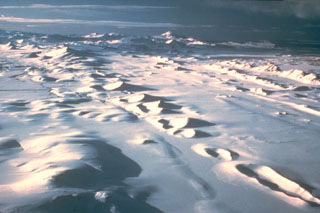Report on Bardarbunga (Iceland) — 3 December-9 December 2014
Smithsonian Institution / US Geological Survey
Weekly Volcanic Activity Report, 3 December-9 December 2014
Managing Editor: Sally Sennert.
Please cite this report as:
Global Volcanism Program, 2014. Report on Bardarbunga (Iceland) (Sennert, S, ed.). Weekly Volcanic Activity Report, 3 December-9 December 2014. Smithsonian Institution and US Geological Survey.
Bardarbunga
Iceland
64.633°N, 17.516°W; summit elev. 2000 m
All times are local (unless otherwise noted)
During 3-9 December, IMO maintained Aviation Colour Code Orange due to continued activity at Bárdarbunga’s Holuhraun eruptive fissure. The Scientific Advisory Board of the Icelandic Civil Protection reviewed data from the beginning of the eruption on 31 August to 3 December and found a decreased rate of subsidence of the Bárdarbunga Caldera from up to 80 cm/day to 25 cm/day, with most of the subsidence concentrated at the center of the caldera. Data also showed a decline in the intensity of the eruption at Holuhraun, although seismic activity remained strong. The lava field covered just over 76 square kilometers on 9 December, making it the largest lava field in Iceland since the Laki eruption (1783-1784). Additionally, the gas emissions have had an impact all over Iceland for the first time in 150 years.
Geological Summary. The large central volcano of Bárðarbunga lies beneath the NW part of the Vatnajökull icecap, NW of Grímsvötn volcano, and contains a subglacial 700-m-deep caldera. Related fissure systems include the Veidivötn and Trollagigar fissures, which extend about 100 km SW to near Torfajökull volcano and 50 km NE to near Askja volcano, respectively. Voluminous fissure eruptions, including one at Thjorsarhraun, which produced the largest known Holocene lava flow on Earth with a volume of more than 21 km3, have occurred throughout the Holocene into historical time from the Veidivötn fissure system. The last major eruption of Veidivötn, in 1477, also produced a large tephra deposit. The subglacial Loki-Fögrufjöll volcanic system to the SW is also part of the Bárðarbunga volcanic system and contains two subglacial ridges extending from the largely subglacial Hamarinn central volcano; the Loki ridge trends to the NE and the Fögrufjöll ridge to the SW. Jökulhlaups (glacier-outburst floods) from eruptions at Bárðarbunga potentially affect drainages in all directions.

